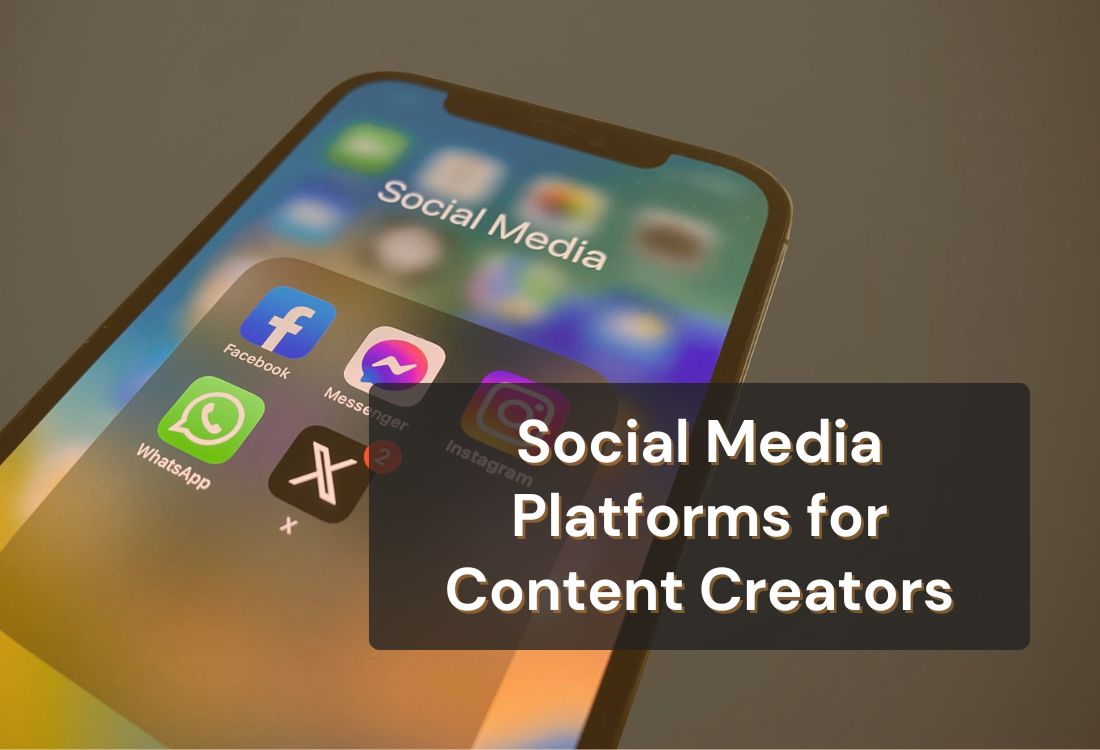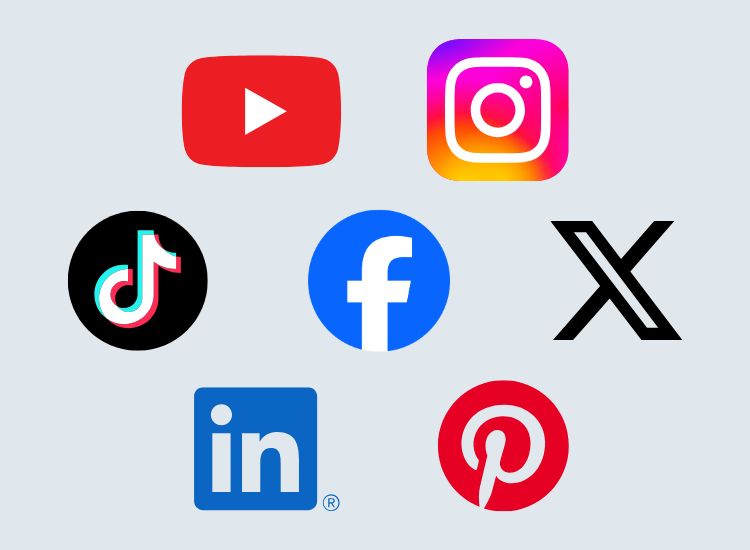



Social media has become the world’s biggest stage for creators to share ideas, grow audiences, and turn passions into careers. Every day, you see it, an educator building a thriving YouTube channel, a fitness coach growing a loyal following on Instagram, or a storyteller finding their community on TikTok.
With billions of users across platforms, the challenge isn’t finding an audience; it’s knowing where your content fits best. The right platform amplifies your reach, strengthens your brand, and opens new ways to earn from your creativity. This guide breaks down the best social media platforms for content creators, helping you focus your time and energy where it matters most.
So, where should you actually post your content? Let’s break down the platforms that can help you grow faster and connect deeper with your audience.

Before you choose where to build your presence, it helps to see the scale of content creation today. More than 5 billion people use social media worldwide in 2025, according to Statista. That means most of your potential audience already spends time on these platforms.
The creator economy has become a business powerhouse. Goldman Sachs reports it is now valued at over 250 billion dollars and could more than double by 2027. Brands keep increasing their budgets for influencer marketing, and creators like you stand at the center of that growth.
Video content dominates. A Wyzol report shows that 89 percent of marketers rely on short-form video as part of their strategy because it brings the highest return on investment. Platforms have noticed and continue to expand features like YouTube Shorts, TikTok’s For You Page, and Instagram Reels.
For you, this means opportunity. Social networks are competing for creators by offering better monetization tools, stronger analytics, and more ways to connect with audiences. Knowing these numbers gives you the perspective you need before deciding which content creation platforms deserve your time.

If you want to build long-term visibility, YouTube gives you the biggest stage. With more than 2.5 billion monthly users, the platform offers one of the largest audiences anywhere online. You can publish long-form tutorials, vlogs, or educational series, while YouTube Shorts helps you tap into the growing short-form video trend.
Monetization options are strong. You can earn through ad revenue, channel memberships, Super Chats during live streams, and sponsorship deals with brands. For creators who prefer structured growth, YouTube also offers detailed analytics so you can refine your strategy. Its search-driven model means your videos continue to gain views months or even years after publishing, giving you evergreen reach that few content creation platforms can match.
Video remains the most effective content type, with video marketing statistics showing its unmatched return on investment.
Instagram remains a powerhouse for creators who thrive on visuals. With 2 billion monthly active users, the platform connects you to communities that value photography, lifestyle content, travel, and fashion. Reels in particular have become a fast way to grow, with Instagram pushing short-form content to wider audiences.
You can also build income through brand partnerships, affiliate links, and Instagram Shopping. Businesses continue to rely on the platform for influencer marketing campaigns, which means your content has a direct path to monetization. By using Stories, Reels, and carousel posts together, you keep your followers engaged and show different sides of your work. Among content creation platforms, Instagram shines as a tool for building both engagement and commercial opportunities.
Reels continue to dominate Instagram engagement, with 2025 Instagram Reels statistics showing their impact on growth and reach.
TikTok has changed how people consume content. With more than 1.6 billion global users, it gives you the chance to reach audiences quickly, even if you are just starting out. The platform’s algorithm pushes content to viewers who are most likely to engage, which means small creators can achieve viral success overnight.
Short-form videos dominate on TikTok. Trends, challenges, and music-driven clips keep the platform fresh and highly engaging. For you, it’s not just about entertainment but also about visibility. TikTok’s Creator Fund, brand sponsorships, and live gifts give you clear ways to earn money from your work. If your style fits quick, engaging videos, this is one of the content creation platforms that can accelerate your growth.
Despite newer platforms gaining attention, Facebook still holds the largest user base with 3.1 billion monthly active users. For creators, it offers powerful tools for building communities, especially through Groups and Pages. You can host live streams, post long-form updates, and interact with audiences who prefer a mix of formats.
Monetization options are wide. You can use in-stream ads, fan subscriptions, and branded content. Facebook also supports cross-posting, making it easier to share your content across Instagram. For creators who want reach across different age groups and global regions, Facebook remains one of the most reliable content creation platforms available.
If your focus leans toward professional or educational content, LinkedIn gives you direct access to a business-minded audience. With over 1 billion members, it’s the top platform for thought leaders, coaches, consultants, and B2B creators. You can share articles, short updates, or videos that highlight your expertise and spark conversations within your industry.
LinkedIn has invested heavily in creator tools. Features like newsletters, LinkedIn Live, and video posts allow you to expand your reach and establish authority. Unlike other content creation platforms, LinkedIn favors professional growth and networking, so your efforts often lead to partnerships, speaking opportunities, or client relationships in addition to brand sponsorships.
If your audience values professional learning, platforms like LinkedIn work well, especially given the growing demand highlighted in recent webinar statistics.
X thrives on immediacy. With around 611 million monthly users, it’s where you can share quick updates, opinions, and breaking news while engaging in real-time conversations. For creators who enjoy interaction and thought leadership, X offers a fast way to connect with audiences without relying on heavily produced content.
Beyond tweets, X Spaces gives you a voice-driven way to host live discussions and connect with followers on a deeper level. Many creators use X to build visibility before funneling audiences toward long-form platforms like YouTube or podcasts. When you want speed and direct engagement, X stands out among content creation platforms.
Pinterest gives you a space to share ideas that last. With 578 million monthly active users, the platform focuses on discovery rather than quick trends. That makes it ideal for creators in niches like design, DIY, home improvement, food, and education. When someone searches for inspiration, your pins can surface months or even years after posting, providing long-term traffic.
Video pins and idea pins add variety, letting you show tutorials or behind-the-scenes content in a visual way. For many creators, Pinterest acts as both a content hub and a traffic driver to blogs, online shops, or courses. If your content thrives on visuals and problem-solving, this is one of the content creation platforms where your work can stay relevant for the long haul.
Newer platforms continue to expand opportunities for creators. Twitch has more than 240 million monthly active users and dominates the live streaming space, especially for gaming and interactive shows. You can monetize through subscriptions, donations, and sponsorships, while connecting directly with your audience in real time.
BeReal takes a different approach by promoting authenticity through unfiltered daily posts. It’s especially popular among younger audiences who value a more casual style of content. Platforms like Threads and Lemon8 are also growing, offering fresh ways to connect and experiment with new content formats. While these platforms may not match the reach of YouTube or Instagram yet, staying active on them can give you an advantage as they grow.
Live video remains one of the strongest ways to engage communities, with recent live streaming statistics showing how audiences prefer real-time interaction.
When deciding where to focus, use these key factors to guide your choice:
If you want a deeper look at creator styles and how they align with different platforms, refer to the guide on types of content creators.
Choosing the right content creation platforms shapes how far your message reaches and how deeply you connect with your audience. Each platform brings its own strengths, from YouTube’s search-driven video library to TikTok’s viral short clips, Instagram’s visual storytelling, and LinkedIn’s professional credibility. The key is not to chase every trend but to focus on the spaces where your content feels natural and where your audience already engages.
When you align your strengths with the right platforms, you set yourself up for growth, consistency, and real opportunities. The numbers show that social media continues to expand, and platforms are investing heavily in creators like you. The next step is choosing where to focus your energy and building an audience that values what you share.
If you are just starting, YouTube, TikTok, and Instagram are strong choices. They offer simple publishing tools, large audiences, and quick feedback, which helps you learn what resonates with viewers.
YouTube often pays the most through ad revenue and memberships, while TikTok and Instagram provide strong brand partnership opportunities. Twitch also offers income through subscriptions and live support from fans.
Most creators see better results when they focus on two or three platforms. This allows you to stay consistent without stretching yourself too thin. Once you build a stable audience, you can expand.
TikTok continues to grow rapidly, especially among younger audiences. YouTube Shorts and Instagram Reels are also expanding quickly as short-form video demand increases.
Yes. Many creators succeed with faceless content like tutorials, animations, podcasts, or screen recordings. Pinterest, YouTube, and TikTok all support content that doesn’t require being on camera.



